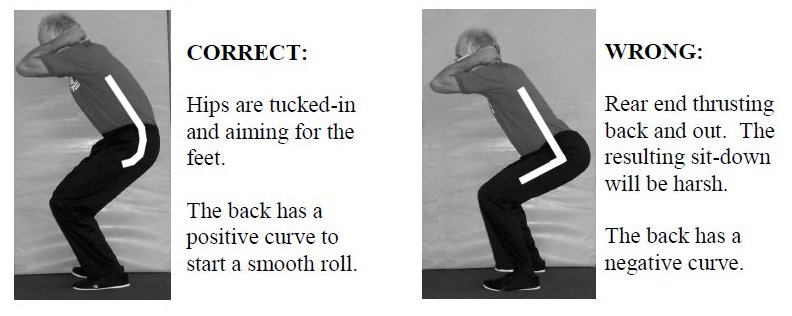
Safe Falling Class: Instructional Details
Some important notes for Falling Technique Instructors
1. By the time we hit our fifties, we ALL have some physical
issues, even if we are in generally good condition. The first
thing to impress upon your safe falling students is that they must pay
attention to their own bodies. Especially in the first class or two
they should keep their effort level and range of motion to about 60-70%
of what they think they can do. If any particular movement or angle
causes a sharp pain, DON'T DO THAT MOVEMENT. Take it easy.
2. Some students may not have done much physical exercise at all. The
biggest problem areas for them are neck and core (abdominal) muscles.
The first floor exercise, the "Rocking Chair" works both of these areas.

When first doing the Rocking Chair, each student should firmly hold the
back of her knees as she rocks back. This greatly reduces the stress on
the core muscles, and lets the student focus on "tucking" the pelvic
area and clamping the chin to the chest.
When comfortable with this movement, the next step (usually by the
third class) is to have the student cross her hands and clamp them to
the front of the chest (the "King Tut" position). This puts more load
on the core muscles, but still allows the chest muscles to help with
the curling-up motion, and reinforces the pulling of the arms in and up
to the face and chest.
For the final version of the Rocking Chair the hands are balled into
loose fists and clamped behind the neck. The folded arms wrap
protectively around the head to give maximum coverage. Rocking back
with the hands and arms up around the head will create noticeably more
tension in the lower core muscles: the extra weight of the arms adds
force, and the upper chest muscles can't help as much.
Important: if the student does not rock right back up, they should NOT
strain or wiggle to try for a full sit-up. They should relax, turn on
their side, and use their arms to get back to the seated start
position. The object is to get used to holding the curved-back rocking
chair position and exhaling constantly during the full rock back and
return motion.
3. The neck muscles are very important for preventing "head whip" at
the end of a fall. In a backwards fall, the chin should be tucked down
firmly towards the chest. In a forward fast fall from a trip, the neck
should be tightened up in the back, lifting the chin and face up away
from the floor.
When practicing the "Slap the Cheese" technique on the slightly tilted
vertical mat surface, be sure that students are tensing their necks and
looking UP towards the ceiling. If they leave their necks relaxed and
look directly at the mat they will bump their noses, even at low speeds.
When practicing the basic sit-down and back side roll, emphasize really
clamping the chin to the chest near the very end, while still rolling
back on the mat. The neck muscles do not have a lot of stamina: they
are good for only about half a second of strong action. If students
clamp their chins down too early they will run out of strength just
when they need it to prevent head-whip. This is largely because the
practice falls are slow: about a half to a third the speed of a real
fall. It is important for the chin to be tight at the end of the fall
in practice so the memory imprint will be correct: rolling back without
any head-whip. In a real fall, just clamp the chin immediately!
4. The pelvic tilt in the sitting down motion is very important.
The students should always be reminded to "tuck their hips." This
means to tense the muscles in both butt cheeks (similar to the Kegel
exercise). This, and the advice to try and "sit on your heels" acts to
give a more positive curve to the lower back and sacral area:

Visualizing the lower body as a letter "J" can help students get the
right curve. You can demonstrate (on a soft mat!) the harsh results of
a sit-down in the "L" position. The "pile-driver" effect of an "L" sit
has been experienced by many: a direct jolt up the spine and possibly
bruised tailbone. This makes them leery of sitting down quickly.
Emphasize the "J" curve and sitting on one cheek of their butt rather
than squarely, and they will find that the fast sit is actually quite
smooth and easy on the thick mat. They will roll back faster, however,
and need to use good chin-tuck to avoid head whip at the end of the
back-roll.


